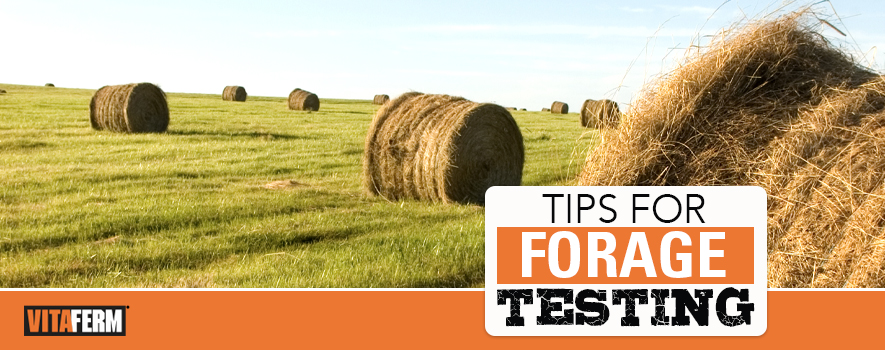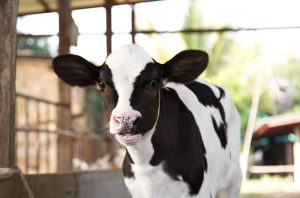Cattle producers are continually looking for ways to cut expenses and increase profits; they’re no different than any other good business operator. Andy McLaughlin owner of McLaughlin Cattle has found one simple and efficient way to cut some of his feed costs down while ensuring his cow herd gets the nutrition it needs during the right production stages.
McLaughlin takes samples of the hay and feedstuff he raises on his Redfield, Iowa, farm, has them analyzed for nutrient content and works with the nutrition team at BioZyme® Inc. to develop rations based on the feed and forages he has available that will get his herd through winter and into next spring. He said taking the samples is simple, and he ultimately knows his herd is set up until they can go on grass next spring.
“I already know what I have available for hay for this winter or even next spring for lactation season, six months in advance, just by taking hay samples,” McLaughlin said. “I feel like you can waste money by not sending your samples in if you are feeding too good of hay too early. You might have thought it was a good cutting of hay, but when my hay tests come back, they aren’t always as good as they look, so I can use them in a lower ration. Just because they look good and got put up good, doesn’t mean they are good. Or vice versa. I’ve had what I thought was some poor-quality hay come back, and actually is really decent.”
Being proactive in his feed and forage testing is a cost savings that allows McLaughlin to plan his long-term feed and nutrition strategy. He has been testing his feed and planning his rations this way for at least six years he said. As part of the BioZyme dealer network, it is something he offers to all of his customers as well to help them increase efficiencies on their operations. He said about 25% of his customers do have him send in samples; however, not all of them have had their feed rations calculated yet.
“Taking samples is really easy for the return. It takes a minute a sample, send it off and in 3-5 days I usually have results back. In that same amount of time the nutritionists have rations built for you,” McLaughlin said.
Although it is a simple way to plan your herd’s winter diet, there is still some key information needed for the Nutrition Team to develop your rations. Kevin Glaubius, Director of Nutrition for BioZyme Inc., offers key advice to identifying the forages you have on-hand and getting them tested.
First, Glaubius said it important to identify your hay by a lot number so you know which test results are from which lot. Glaubius said a lot is defined by the field and the cutting it is from. For instance, a lot from the second cutting from field one would be named Lot 1-2. A first-cutting sample from the third field would be 3-1. It is important to identify the lots when you haul them from the field and store them and continue to know where they are kept.
Once the lots are identified, it is time to collect samples. Hay testing and ration balancing are complimentary services provided by BioZyme to its customers. Contact your Area Sales Manager or local BioZyme dealer for assistance in collecting the sample. Having an accurate sample is the key to a successful sample. Glaubius recommends taking 10 sub-samples from each lot and mixing them together to get one sample to submit.
“Where it is a real struggle for the nutritionist to work with the producer is when the producer doesn’t keep those lots separate. They bring all their hay from all fields and all cuttings and they are not identified,” Glaubius said. “This makes it really hard when they do that to help them put together an efficient program and tell them to feed this hay first, this hay second, this hay third. If they can put them in rows so they are accessible to feed them from a nutrition standpoint, and not so they are just accessible with their loader, it helps. Some customers will spray paint a lot number on their bales to make their mix the most efficient.”
Once the forages are submitted for testing, the results are typically generated within a week, indicating any deficiencies in energy or protein. In addition to knowing the nutrient content of your forages, it is also important to know the amount of each lot of hay you have when working with the BioZyme Nutrition Team to plan your next steps.
“We need to know the number of bales you have in each lot, so we can help you plan. We look at number of cows you have compared to the amount of forage available, and plan for estimated intake. We want to ensure you are using the right product, either a mineral or protein mix to supplement, either from BioZyme or from your local grain elevator. That way, you don’t have to guess if it is time to start feeding protein or extra energy,” Glaubius said.
McLaughlin said the BioZyme Nutrition Team is good to work with when they know what resources you have available to feed the number of cows you have on hand. Once they have all the information, they can readjust rations accordingly.
“We can figure out what we have for quality of feed and send it down to nutritionists and they can build us rations according to what we have for feedstuffs. If we need supplemental feeds to go with it, we can look at different options that way. We can also know what we have for quantity of what we have on hand tested so that we don’t get caught midway through or during lactation time and run out of one thing or another and have to buy feed to offset what we’ve grown or what we’ve already purchased,” McLaughlin said.
After the tests are analyzed and interpreted and the protein and energy needs are determined, there are four key ways to supplement proteins using the Amaferm® advantage. Amaferm is a precision prebiotic designed to enhance digestibility by amplifying the nutrient supply within for maximum performance.
- Feed mineral with Amaferm. Get the most out of what your cows are consuming by increasing intake and digestibility. This is the least expensive option as the added cost of Amaferm is less than 5 cents per cow, per day.
- Feed VitaFerm® Concept•Aid® Protein Meal. This is a granular, free-choice mineral. In addition to the mineral, supplemental protein is provided.
- Feed VitaFerm Concept•Aid Protein Tub. The tub provides the same nutrition as the protein meal but adds the convenience of the tub form.
- Feed VitaFerm 30-13% Protein Tub. This VitaFerm product offers the highest level of protein, but vitamin and mineral levels for maintenance during times of year when nutrient requirements are not as high.
Forage testing is a management practice that helps you plan ahead to make the best nutritional decisions for your herd. Testing now will help you know which forages you need to feed during which stages of production and the proper amounts of protein and energy you need to supplement during those times. The more you know, the more money you could save your operation.



